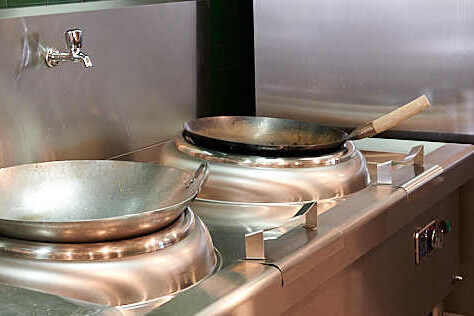What is the future of Commercial Induction in Kitchens?
The future of Commercial Induction in Kitchens is very promising, driven by several key trends and technological advancements.
Induction Cooking, which uses Electromagnetic Energy to Heat Cookware directly, offers a variety of benefits that are becoming increasingly attractive in Commercial Kitchens.
Here are some factors shaping its future:
1. Energy Efficiency and Sustainability
Induction Cooking is significantly more Energy Efficient than traditional Gas or Electric methods, transferring up to 90% of its Energy directly to the Cookware. As the Hospitality and Food service Industries focus more on sustainability, Induction Cooking is seen as a greener alternative that reduces Energy consumption, aligns with Carbon reduction goals, and supports eco friendly Certifications.
2. Speed and Precision
Induction Cooktops, Grill Plates, Wok Stations, Steamers, Bratt Pans, Deep Fryers etc Heat up and Cool down much faster than traditional methods allowing for quicker response times and greater precision in Temperature Control. This makes Induction ideal for fast-paced Commercial Kitchens, improving efficiency and productivity.
3. Safety Improvements
Induction Cooktops - Wok Stations -remain Cool to the Touch, significantly reducing the risk of Burns and Fire Hazards in busy Kitchens. This safety feature is becoming more attractive for Commercial Operators looking to enhance workplace Safety and minimise Accidents.
4. Better Air Quality and Kitchen Environment
Induction Cooking generates less Ambient Heat that Gas, creating a more comfortable Working Environment for Kitchen Staff and reducing the need for extensive Ventilation Systems. This not only saves on Cooling Costs but also improves overall Air Quality.
5. Integration with Smart Technology
As Commercial Kitchens evolve toward Smart and connected Environments, Induction Technology is integrating with loT (internet of things) Devices and smart Kitchen Management systems. This enables better Energy Monitoring, Predictive Maintenance, and Automation, leading to more efficient operations.
6. Growing Adoption in High-End and Speciality Kitchens
Induction Cooking has long been used in High-end and Specialty kitchens where precision and control are paramount. As the Technology becomes more accessible and cost-effective, it is expanding into a wider range of commercial foodservice operations, from Quick-service to Restaurants to Catering Company's.
7. Evolving Regulations
In some regions, regulatory changes are encouraging or mandating the shift from Gas to Electric Cooking Methods due to Environmental concerns. This regulatory push could accelerate the adoption of Induction Cooking Appliances in Commercial settings.
8. Cost Considerations
While Induction Equipment has traditionally been more expensive up front than Gas or Electric Appliances, long-term savings from Energy Efficiency, lower Ventilation Costs and reduced wear and tear are increasingly making it a cost-effective option for Commercial Kitchens.
9. Versatility and Portability
Modern Induction Appliances are becoming more versatile with options for portable Units that can be easily moved around the Kitchen or used for catering and Event Cooking. This flexibility enhances their appeal for a variety of Commercial uses.
10. Advancements in Induction - Compatible Cookware
The availability of high quality Induction - Compatible Cookware is expanding, making it easier for Commercial Kitchens to adopt the Ethnology without needing to overhaul their entire Equipment line-up.
11. Conclusion
The future of Commercial Induction Appliances in Kitchens is bright and exciting, driven by its alignment with Sustainability Goals. Operational Efficiency, Safety and Technological Innovation. As Energy Costs rise environmental Regulations tighten, more Commercial Kitchens are likely to adopt Induction Cooking for its long Term benefits.
Posted: Thursday 17 October 2024


